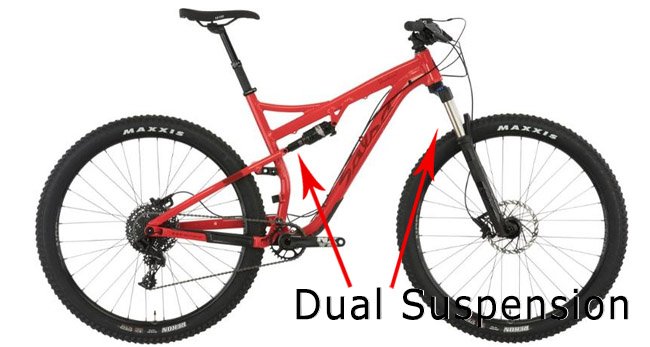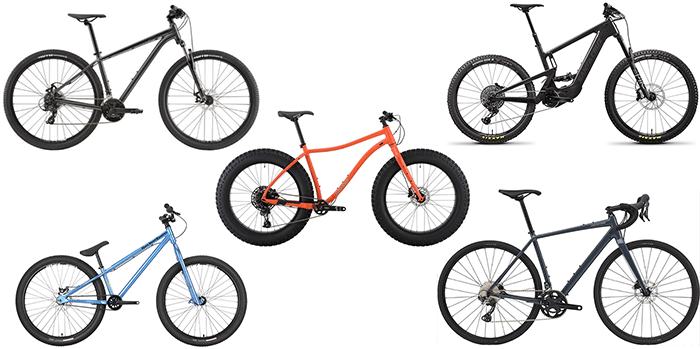
Mountain biking thrives on diversity, with each type of mountain bike tailored to the trail’s unique demands.
From the agile cross-country bikes that conquer climbs and sprints, to the robust trail workhorses designed for versatility across terrains, the spectrum of mountain bikes is as varied as the riders who buy them.
In addition to these, there are also the gravity-defying downhill machines, equipped for steep, heart-stopping descents, and the enduro models that blend uphill efficiency with downhill prowess.
Whether you’re weaving through tight singletracks or tackling rocky technical descents, understanding the nuances of these bikes empowers you to choose the perfect ride for your mountain adventure.
In this article, we’ll describe the most popular different types of mountain bikes and explain what each type is best for!
Three Main Types of Mountain Bikes
Rigid | Hardtail | Full-Suspension
Rigid Mountain Bikes
No Suspension
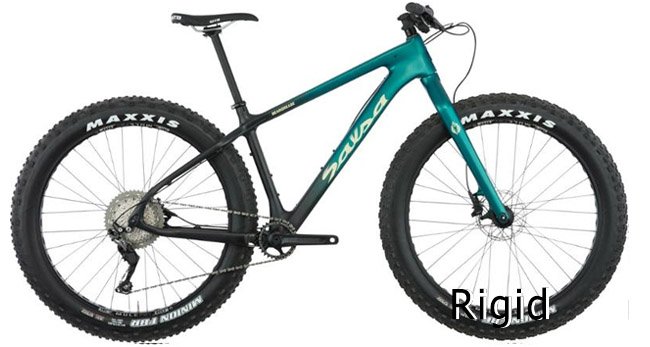
These mountain bikes have no suspension, but the comfort can be increased with the right tire pressure.
- Lighter – as there’s no extra weight that suspension adds.
- More efficient to keep the momentum of pedaling.
- Lower maintenance cost.
- Bumpy, hard on the wrists
Rigid bikes are suggested for someone who wants to stick to the roots of mountain biking or prefers the rigidity of the ride.
A rigid mountain bike has a rigid frame which means there’s no suspension whatsoever.
Although there’s still a small following to this bike type in the mountain biking community, a rigid MTB has some advantages such as not losing any extra energy one would need on a suspension to work. There’s little to no give to the ride, and it is the responsiveness that this bike type is preferred for.
All of the momentum is well carried over by the wheels, whereas you’d lose quite a bit of energy on the suspension.
The main reason people buy rigid bikes today is for the fun factor and retro feel. Rigid bikes require more attention for picking the right line compared to other types of mountain bikes, making a seemingly easy trail a more technical experience.
Hardtail Mountain Bikes
Front Suspension Only
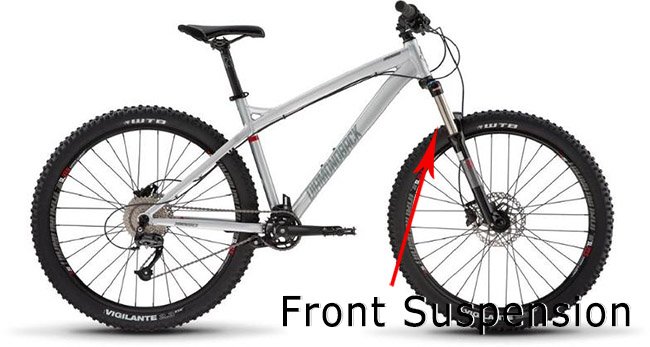
The purpose of the front suspension is to help absorb the initial impact of bumps, rocks, roots, and whatever else you come across on the trails.
- Lighter and more efficient than a full suspension
- Much more comfortable than a rigid MTB
- Best all-rounder mountain bike
- Good climbing capabilities
- Cheap hardtail mountain bikes have poor performance
- On rough terrain, a hardtail mountain bike is not as comfortable as the full suspension
The term hardtail stands for mountain bikes with front suspension.
The same bike geometry is also found on many hybrid and electric bikes as it absorbs the bumps and makes the ride much more comfortable. In terms of mountain biking, the lack of rear suspension makes hardtail MTBs more efficient to pedal (extra cushion requires more energy).
Although not as efficient as rigid mountain bikes, and not as comfortable as full-suspension bikes, there’s a large following to hardtail mountain bikes.
Suspension on the front also helps to prevent your hands from getting too sore on longer rides!
The average suspension travel on a hardtail mountain bike is between 80mm to 140mm, although the most common travel is 100mm to 120mm.
Types of Suspension Forks

The two main types of front suspension forks are Air forks and Coil forks.
- Coil Spring is a rather cheap and basic technique in terms of the mountain bike fork industry. Most lower-end bikes come equipped with a coil-type fork. This type is often found on not as demanding cycling disciplines such as hybrids, e-bikes, etc. They are generally maintenance-free and basic, great for recreational cyclists. Downhill mountain bikes, which take the most beating on the mountains, almost always use a coil shock on the rear.
- Air suspension tends to be lighter and easier to adjust. It is typically reserved for higher-cost mountain bikes designed for technical riding. They are also perfect for bikes intended for riding uphill as they significantly reduce the overall weight of the bike.
Suspension Fork Features
- Rebound: A higher rebound means a faster return. A lower rebound means slower and cushier travel to its extended state. To properly set the rebound on a bicycle fork, you should adjust it so it doesn’t jump back up without a “clunk” when you lift the front end while riding.
- Compression (Damping): Can be adjusted only on an air fork. Compression stands for the stability of the fork travel while riding and affects the response of the suspension.
- Lockout: This allows you to lock out the fork which is useful when riding on paved roads. It is not advised to use the lock when riding on trails as it can damage the fork!
Full-Suspension Mountain Bikes
Front and Rear Suspension
- Makes uneven terrain feel smoother
- Great for riders with previous injuries
- Suspension lockout for more efficient climbing
- Generally heavier than HT, and Rigid bikes
- Pricier
A full-suspension bike is a bike that has both front and rear suspension. Sometimes they are also called dual-suspension bikes.
These are meant for riders who regularly find themselves on rough off-road trails. Full-suspension bikes are ridden for leisure and racing more than they are for transportation.
Travel length on the front and rear can range from 100 – 200 mm, depending on the riding preferences and mountain bike type.
Depending on the model, there are different ways to adjust the rear shock just like the front fork:
A rear shock can have rebound and lockout, as well as many other features such as high-speed and low-speed compression.
Best Full-Suspension Mountain Bikes
Additional Popular Types of Mountain Bikes
Cross Country (XC) Mountain Bikes
70-120mm travel range
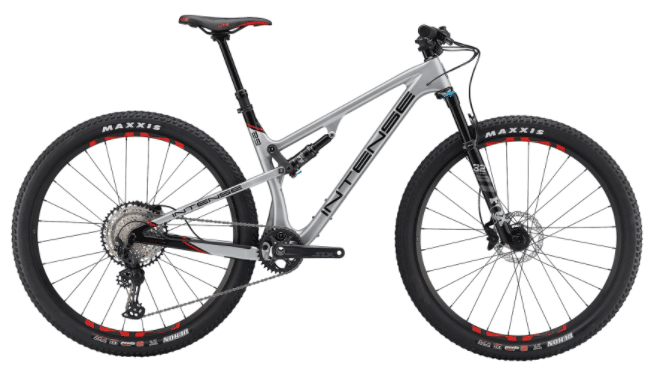
- Available in hardtail, full-suspension, or a rigid frame type
- 27.5” or 29” wheels
- 80 – 120mm suspension travel
- Relatively steep head angles (69 degrees or steeper)
- Prices range from $500 to $9,000+
Cross-country bikes, also known as downcountry bikes, have the least amount of travel compared to other mountain bikes.
XC bikes are preferred for their fast, zippy riding qualities. These bikes are designed to be ridden on anything from city streets to intermediate mountain bike trails.
They pedal well and usually absorb small bumps nicely, which is why they are the preferred choice for XC racing.
These bikes are meant for fast trails where one would need the right amount of cushion and rigidity without losing speed and energy.
Best Short-Travel Mountain Bikes
Trail Mountain Bikes
100 – 140mm travel range
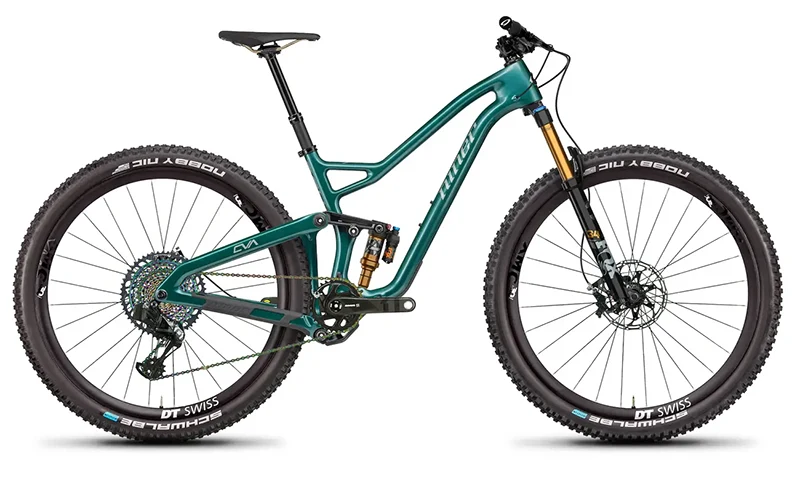
- 27.5” or 29” wheels
- Slack head tube angles around 67 degrees
- Prices start at $800 for a decent one
Trail bikes are some of the most popular all-rounder mountain bikes to get.
Trail mountain bikes are cross-country bikes with slacker geometry and more travel. Slightly heavier than XC bikes, trail bikes have a longer suspension range which works well on rougher singletrack trails.
They also often come with dropper seat posts that lower the saddle to help you descend more efficiently.
Trail bikes will handle small jumps and descents quite well. What plays a big role here is the comfortable geometry which allows riding long and short rides efficiently.
Enduro / All-Mountain Bikes
150 – 180mm of suspension travel front and rear
- Full Suspension setups
- Mostly 27.5” wheels, sometimes 29” size as well
- Tubeless wheels & tires
- Slack geometry: head tube angle is generally smaller than 67 degrees
Enduro is one of the most advanced mountain biking disciplines.
Consisting of climbs, descents, and fast and technical trails, means that an enduro mountain bike needs to be able to handle pretty much anything.
Only a notch below downhill bikes, Enduro bikes have 1×11 or 1×12 speed drivetrains, fully adjustable suspension, and slack geometry.
Enduro bikes thrive on trails that require maximum traction and customized suspension tune-ups for the best possible performance.
Unlike a downhill bike, enduro bikes are designed to ride up the hill, and later down the hill as well. Only experienced riders will make the most of an Enduro bike.
A Mullet bike is a sub-type of enduro mountain bikes with mixed wheel sizes. Mostly a mix of a rear 27.5″ wheel and a front 29″ wheel.
Best All-Mountain & Enduro Bikes
Downhill / Freeride Mountain Bikes
180-210mm front travel & 170-250mm rear travel
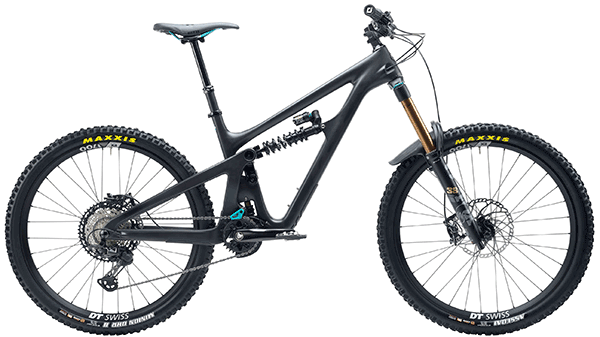
- Full-suspension setups only
- Usually 27.5” wheels (rarely 26” or 29”)
- Slack head angle of less than 65 degrees
- Single front chainring, 6 to 8-speed drivetrains are standard
Downhill and freeride bikes fall into a category of bikes designed to take a beating! Steep drops, huge jumps, gnarly terrain, and all the previous at the highest possible speed.
These bikes are engineered to handle a mass amount of stress without failure. For example, even downhill tires are made to be extra resilient to prevent punctures.
The geometry and parts on DH bikes have been designed so that riders can go over obstacles with maximum traction.
To summarize, downhill bikes are only meant to go downhill, and on specific trails. They are not as comfortable as everyday all-around bikes.
Electric Mountain Bikes
Electric Motor and Battery
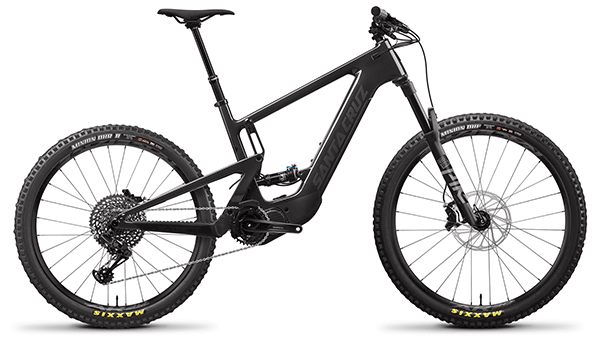
- 27.5″ and 29″ wheels
- 250W Mid-drive motors
- Class 1 – Pedal-assisted to 20 mph
- 1x front chainring, 1×12 is a standard drivetrain
Electric mountain bikes come in all sorts of forms and variations, but the majority of higher-end models feature a full-suspension setup.
Although good-quality E-MTBs start from around $3,500, there are cheaper hardtail versions available as well.
A mid-drive motor is a must, although cheaper electric MTBs come with a hub motor. Many eMTBs are built to offer better-assisted power when climbing or simply going for longer routes with some energy left over.
Click the button below to check out our Best Electric Mountain Bikes buying guide and see the top-rated models.
Fat Bikes
Rigid frame with oversized tires
- 3.8″ – 5.0″ wide tires
- 20″, 26″, 27.5″ wheels are around, although the 26″ is the most common
- 1x single chainring and wide range cassette
- Mechanical or hydraulic disc brakes
- Alloy / Steel / Carbon fiber frames
Fat bikes were originally built to handle sand and snow, but the demand has widened the spectrum for many recreational cyclists.
Although those chunky tires and a rigid frame might give a false signal that they are hard to ride, it is actually the other way around.
The large tires offer a lot of comfort, and the rigid frame helps to keep the momentum. These days more and more recreational cyclist have found their calling in the fat bike rides.
Typical fat bikes come with a rigid frame and 26″ wheels, but due to the large tires, it is equivalent to a 29″ wheel. Most fat bikes are lightweight and offer a ton of comfort on rugged trails which can’t be passed by with standard-size mountain bike tires.
If a fat mountain bike isn’t something for you, there are also many more variations of bikes with fat tire sizes, such as cruisers, folding, electric, and much more.
Best Fat Bikes Best Electric Fat Bikes
Gravel Bikes
Road Frames and Wide Tires
- An ideal mixture of road and mountain
- 700c or 650b wheels
- Mechanical / Hydraulic disc brakes
- Wide tires
Similar to touring bikes, gravel bikes are similar to performance road bikes designed to tackle gravel roads and hardpacked dirt roads.
Most gravel bikes come with road bike geometry and 700c or 650b wheels with knobby tires. They also have wider handlebars than road bikes, which allows you to have better control on rough terrain.
Unlike the best cyclocross bikes, which are intended for speed and racing, gravel bikes also have wide-range cassettes, eyelets for racks, fenders, and other accessories.
A gravel bike makes the perfect companion for commuter cyclists who are looking for speed, comfort, and accessibility to steer away from the paved roads from time to time.
Best Gravel Bikes Best Cheap Gravel Bikes Under $2,000
Dirt Jump Mountain Bikes
Dirt / Park / Freestyle
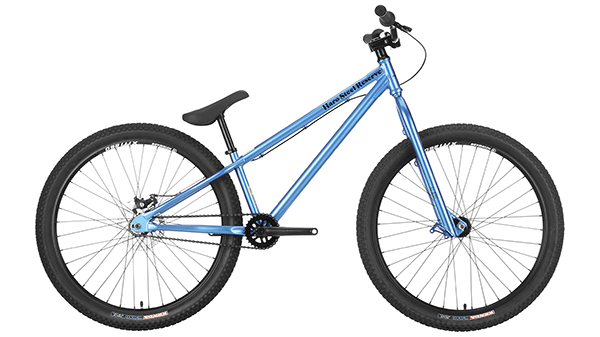
- 26 wheels
- Single-speed
- Aluminum = Lighter / Steel = More durable
- Rigid or with front suspension
- Super strong components, especially hubs, wheels, frame, etc.
Dirt jump bikes attract adrenaline junkies who are looking to master jumps and tricks on custom-made parks and dirt jumps.
Whether it is a concrete skate park or custom-made jumps, dirt bike riding isn’t for the faint-hearted, that’s for sure!
Dirt jump bikes are built to do the same tricks as the best BMX bikes while having a better reach and speed for descending, jumps, landings, and of course – tricks.
Trial Mountain Bikes
Specialized Bikes Built for Tricks
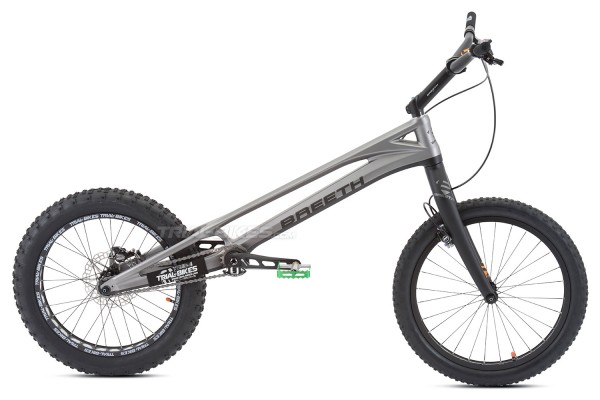
Image Credit: trial-bikes.com
- Advanced balance, bike handling, and physical stamina is needed
- Super durable components
- 20″, 24″, 26″ wheels
Trial biking consists of an obstacle course where the goal is to do a certain trick or jump a gap without setting foot on the ground. The stunts generally start from standing still on a bike.
In this discipline, a cyclist has mastered bicycle control to a high degree.
Trial bikes might seem simple in their build, but they do cost a fortune! Every single detail about the bike is put together to offer minimum weight and maximum durability.
Conclusion
To sum up, mountain biking offers a bike for every trail and every type of rider.
Rigid bikes are basic and light, great for smooth trails. Hardtails add a little suspension for comfort and easier climbs. Full-suspension bikes smooth out the technical terrain and are great for serious off-road fun.
Whether you’re racing down a hill or cruising through the woods, there’s a mountain bike built for the experience.

